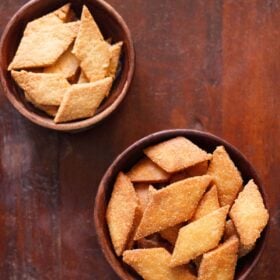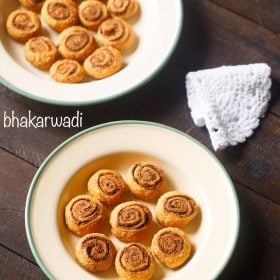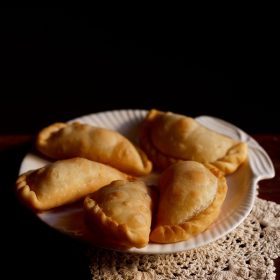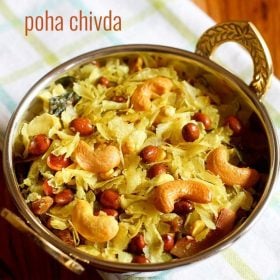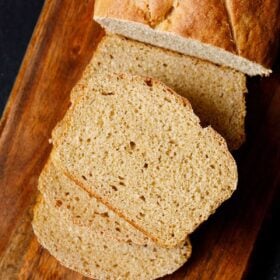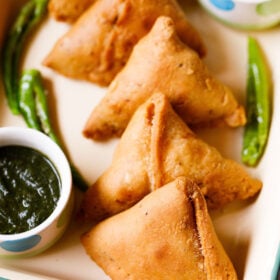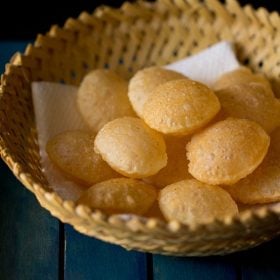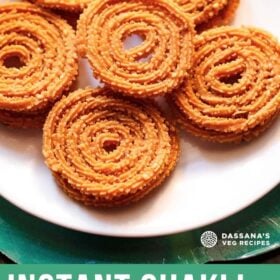This classic deep fried Chakli recipe includes a blend of rice flour, gram flour (besan) and spices for a light and crispy snack that’s easy to make at home. These Instant Chakli are a savory treat that you will love munching anytime. Make my easy chakli recipe for Indian festivals like Diwali, Ganesh Chaturthi or for any festive occasion.
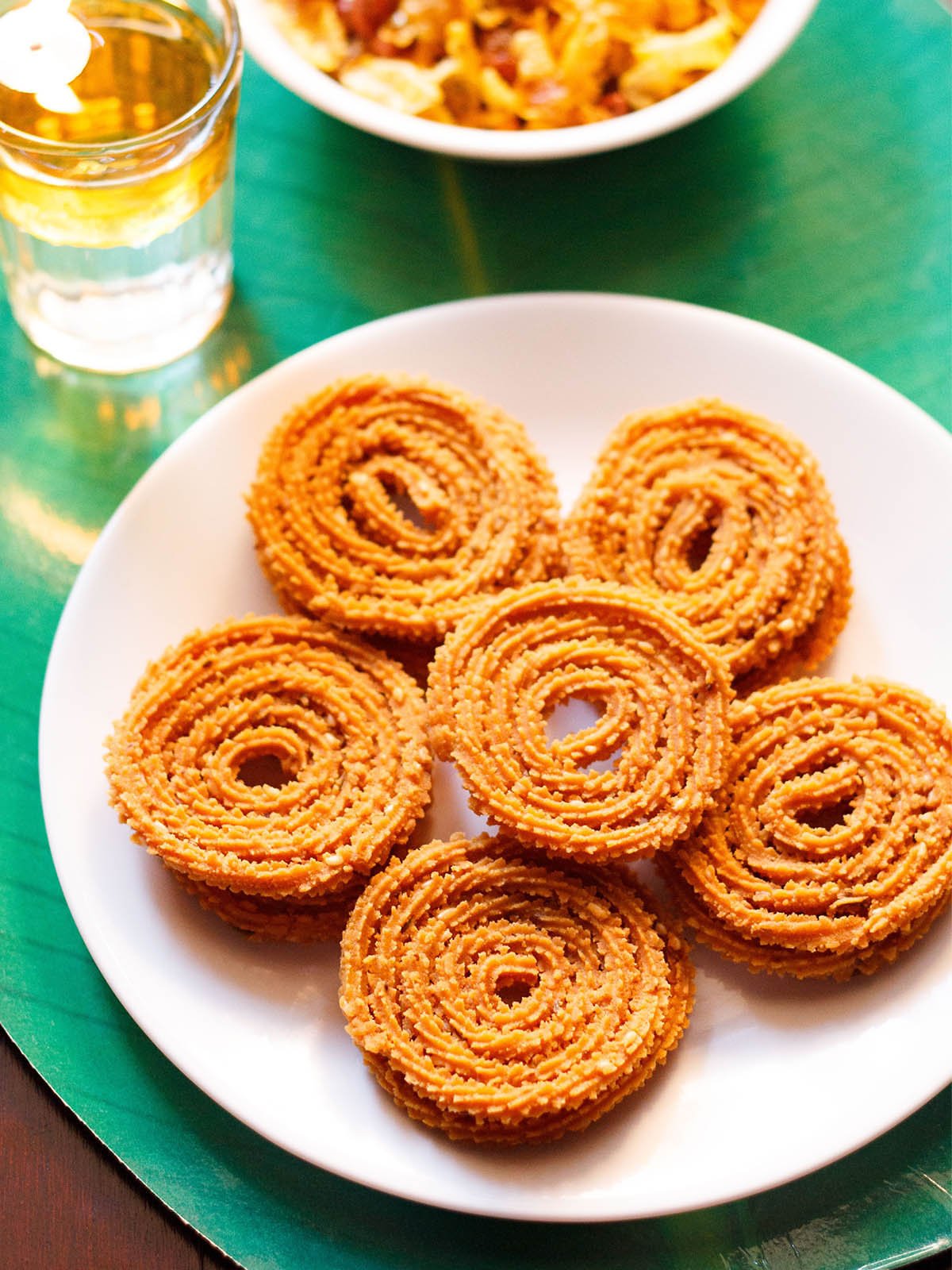
Table of Contents
About Chakli
Also known as Chakri – or Murukku in South India, traditional chakli are lovely, light and crunchy spirals of fried dough.
They are commonly enjoyed as a Diwali Snack, and are a great balance to the Diwali Sweets typically made before badi Diwali (big Diwali). Filled with lots of savory spices, chakri can be made mild or spicy, depending on your preference. They also make for a nice tea time snack.
There are many different versions and methods for making chakli, but this is by far my favorite chakli recipe. It is a classic family recipe of an instant chakli that uses rice flour as the base for the crunchiest and lightest dough that really lets the seasonings shine.
My step-by-step photos and foolproof tips will help walk you through the easy process of making the best chakli from scratch!
Ingredients You Need
To make authentic chakli at home you need rice flour, gram flour, butter or oil and the usual Indian spices. You will also need a Chakli Maker – which on pressing releases extruded strands of dough that are then shaped into tight spirals and fried crisp.
You can add more red chili powder or even a bit of garlic-green chili paste to make spicy chakli. If you prefer some garlic or ginger flavor, feel free to add some garlic paste or ginger paste to the dough.
To make gluten-free chakli, simply skip asafoetida in the recipe or use asafoetida that is packaged and sold as gluten-free.
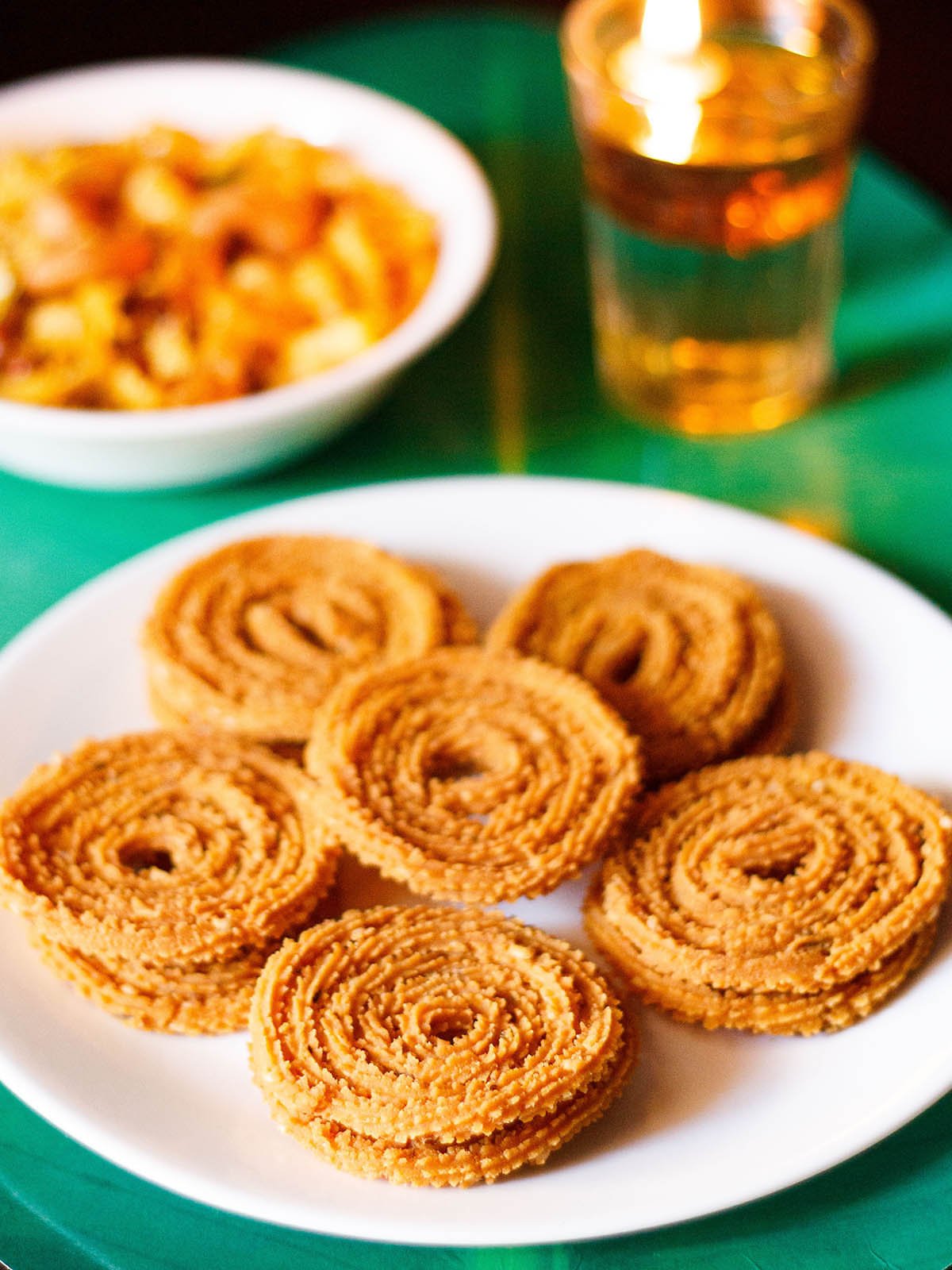
How to Make Chakli
Below is my detailed step-by-step guide that will help you to make perfect chakli every time.
Make The Dough
1. First, combine 1 cup of rice flour and ½ cup of gram flour (besan) in a large mixing bowl.
Gram flour is finely ground flour made from chana dal or bengal gram. Do not use chickpea flour (made from white chickpeas). It may not work in this recipe.
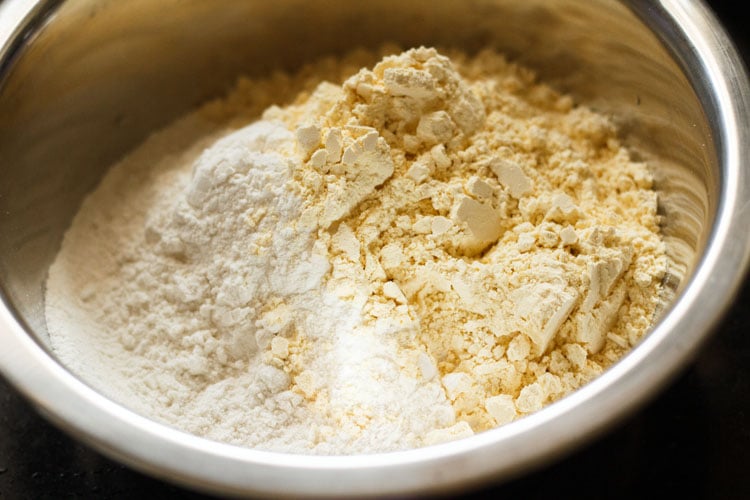
2. Add the following spices and seeds:
- ½ teaspoon carom seeds
- ½ teaspoon cumin seeds
- 1 tablespoon white sesame seeds
- ¼ teaspoon turmeric powder
- 1 teaspoon red chili powder
- a generous pinch of asafoetida
- salt as per taste
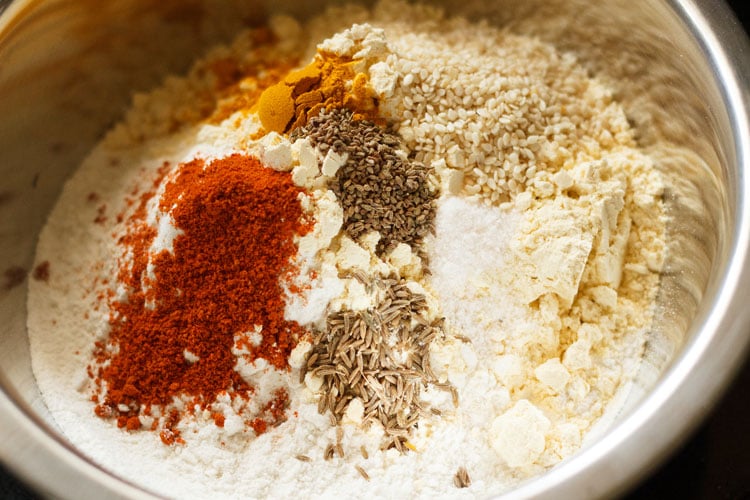
3. Thoroughly mix the flours and seasonings with a spoon.
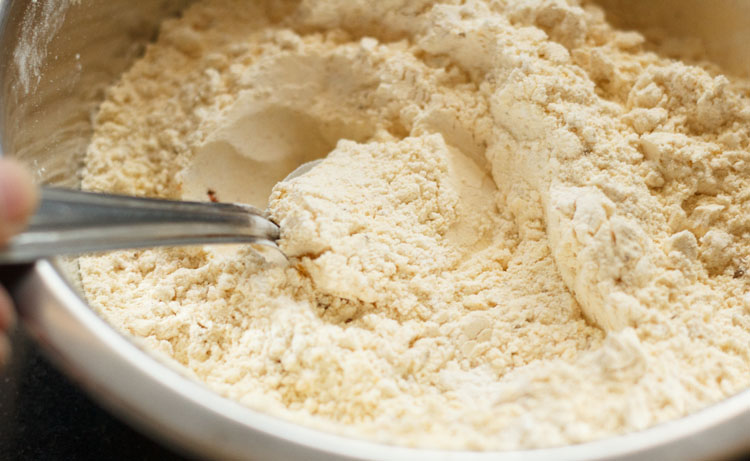
4. Next, heat 2.5 tablespoons butter or oil in a bowl or small pan on medium low heat. You want the butter or oil to get to a slight simmer but not boil or burn.
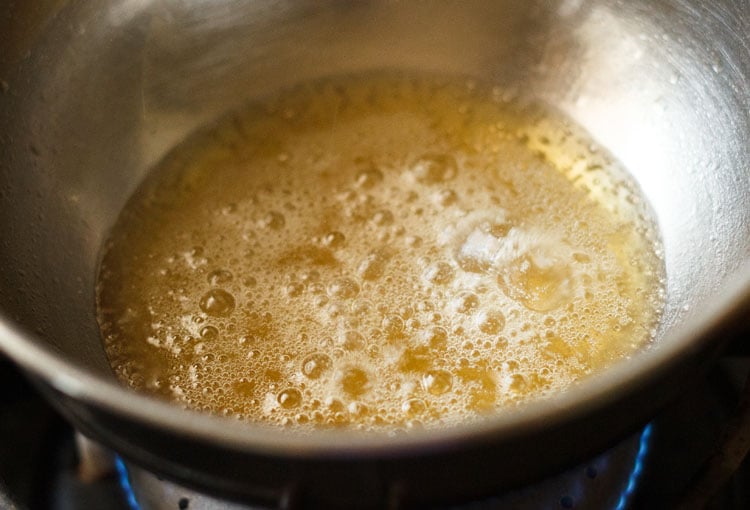
5. Add the hot butter or oil to flour mixture.
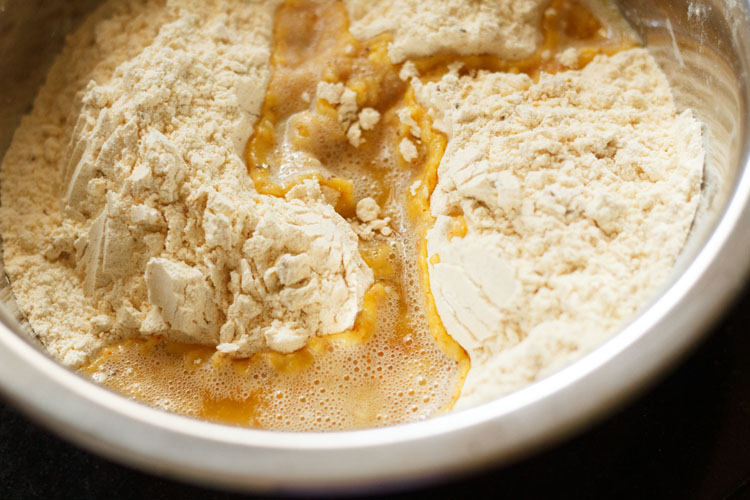
6. First mix with a spoon. When the mixture becomes warm, then use your fingertips to thoroughly combine the hot butter or oil with the flour mixture. Set the bowl aside.
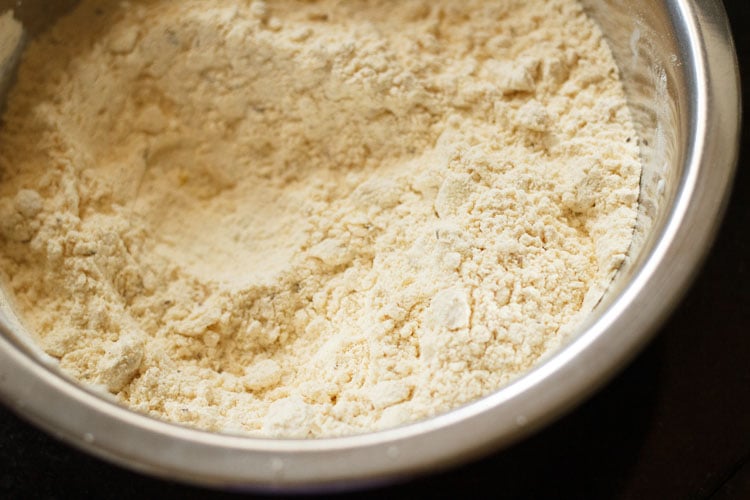
7. Next, heat ⅔ to ¾ cup water in a medium saucepan until boiling.
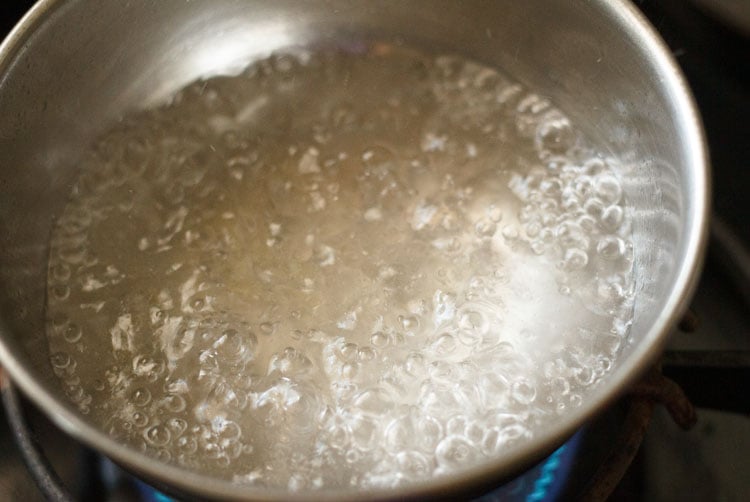
8. Working just a bit at a time, carefully add the boiling water to the dough. Mix gently with a spoon as you go.
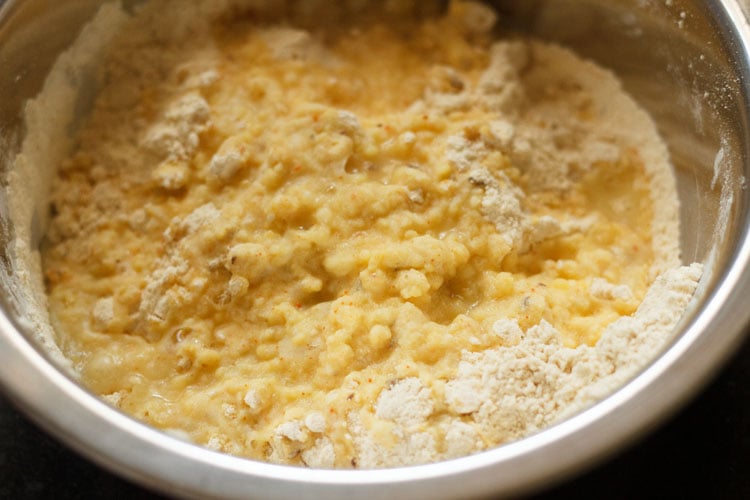
9. Continue adding hot water until the dough becomes damp but not saturated. It should not be sticky.
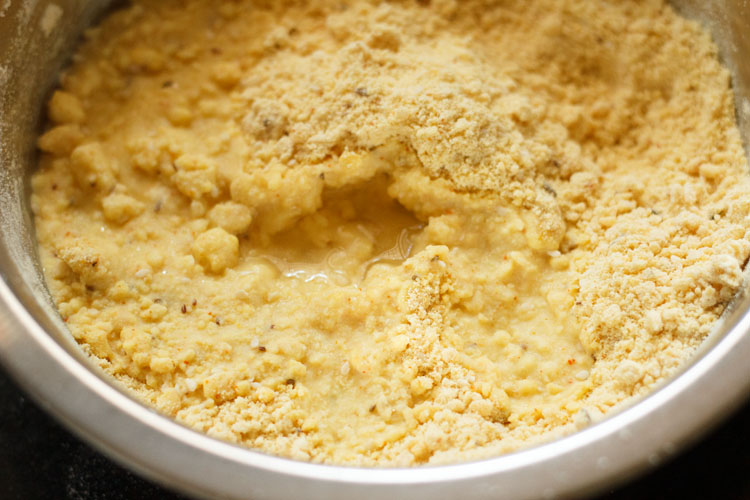
10. Mix with a spoon and then use slightly damp hands to knead and form the dough.
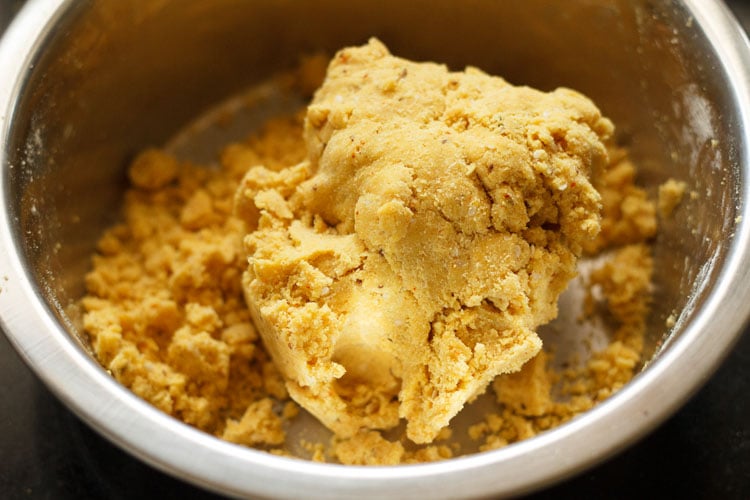
11. The chakli dough should be pliable, firm, and not crumbly. Cover and let the dough rest for 30 minutes at room temperature.
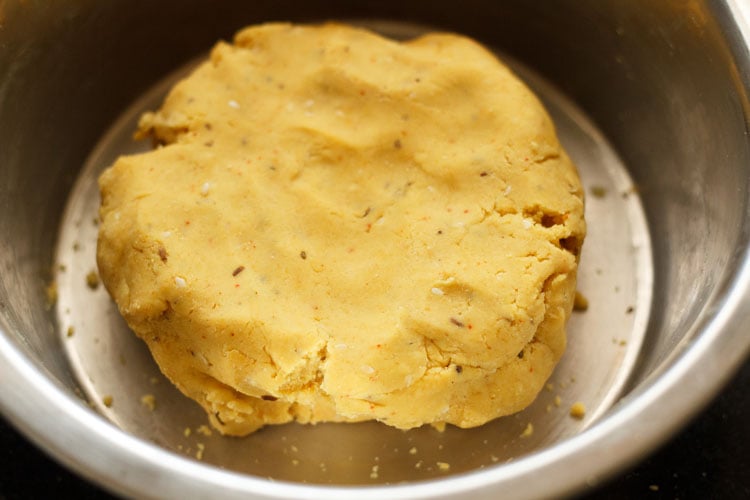
Form The Chakli
12. Once the dough has rested, it’s time to make the chakli! Start by applying some water in the chakli/murukku maker, and place a portion of the dough inside it.
The chakli maker should be filled but not overflowing, like in the photo below.
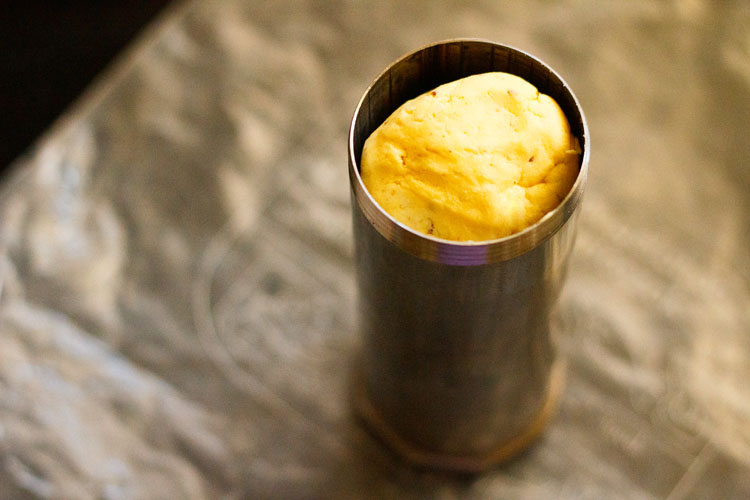
13. Tighten the lid and press the chakli maker to prepare the chakli or use according to the manufacturer’s instructions. Carefully move in rounds to get a spiral shape as the dough comes out.
Tips:
- I recommend that you make the chakli on butter paper or parchment paper or aluminum foil, so that it’s easy to remove them.
- If the chakli breaks while forming them, this means that the dough does not have enough moisture. Add 1 or 2 tablespoons of water and knead the dough again.
- If you are not getting proper spiral round shape this means that the dough is too moist. Add a bit of rice flour and knead again. Keep adding a few teaspoons of rice flour and kneading until the dough consistency is tight but still pliable.
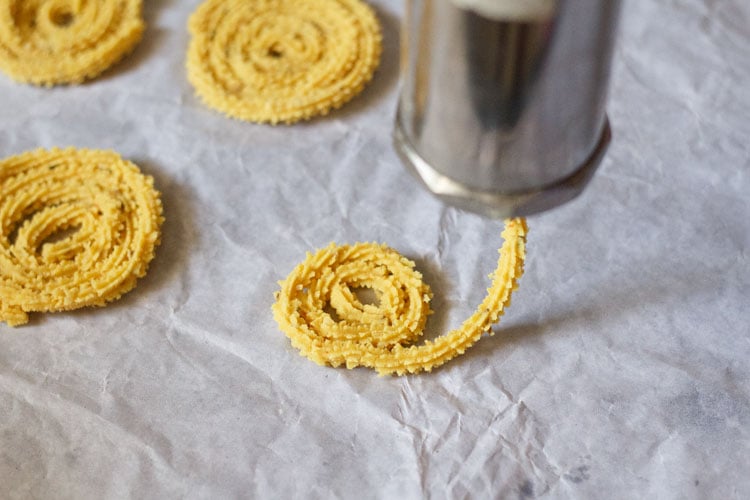
14. After several inches have been extracted, gently roll the dough towards itself to form a spiral shape. Lightly press the end of the coil into the circle to hold.
Loosely cover with a paper towel or a clean cotton napkin to keep the chakli from drying out as you fry them in batches.
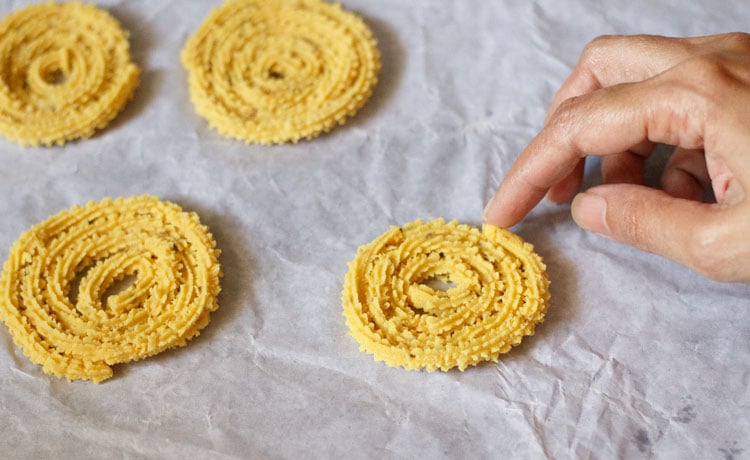
Fry Chakli
15. Next, heat oil for frying in a large, deep pan. Take a small piece of the dough and check the temperature of the oil.
If the dough comes up in three to four seconds, then the oil is ready. If the dough sits at the bottom, the oil is still cold. But if the piece of dough comes up briskly and quickly, the oil is too hot.
Tip: Take a bite out of your test piece. The chakli should be light and crunchy. If it tastes hard, add 1 or 2 teaspoon or ½ tablespoon of hot oil or butter to the dough and knead again.
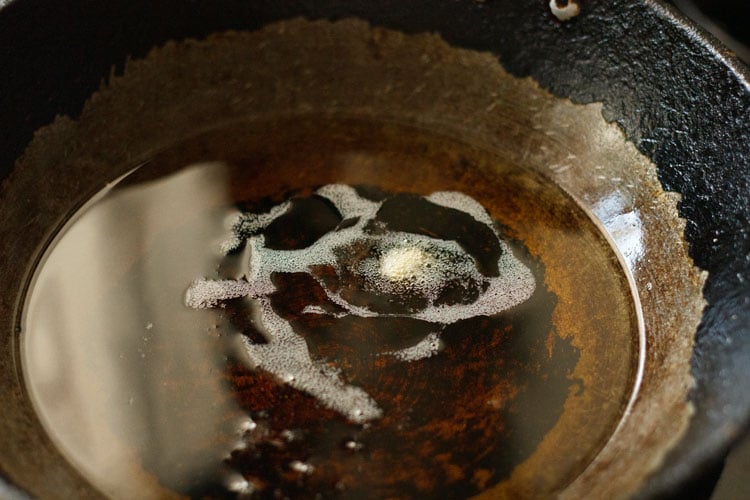
16. Now that you’ve got the dough and oil just right, carefully add the chakli to the pan.
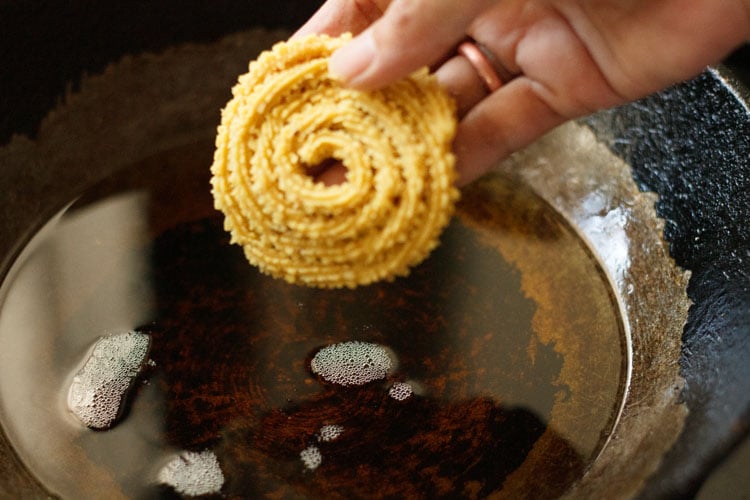
17. Fry 3 to 4 chakli at a time. Be sure that you don’t overcrowd the pan while frying! Too many pieces in at once will lower the oil temperature and cause the chakli to get soggy.
Tip: Check the first batch of chakli before frying all of your dough. If it appears that the chakli has absorbed oil or breaks in the oil, then you probably have too much fat in your dough. Try adding some rice flour to the dough, about 1 to 2 tablespoons at a time, and knead again.
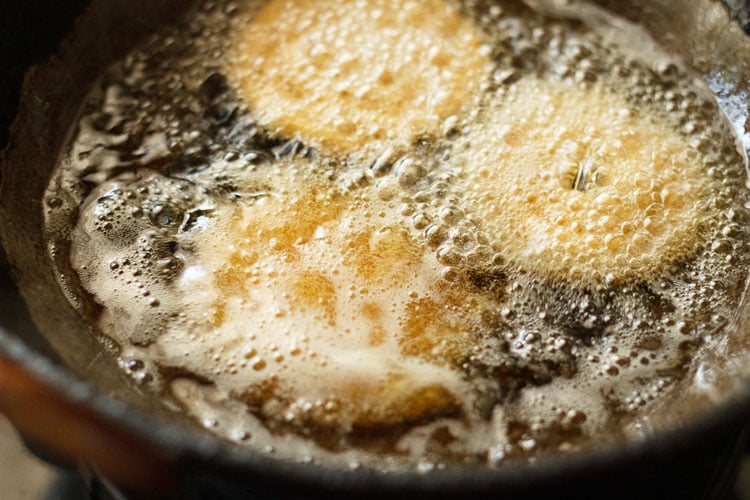
18. When you’re sure the dough is perfect, fry another batch of chakli in the hot oil. Remember to keep the raw chakli covered while you work.
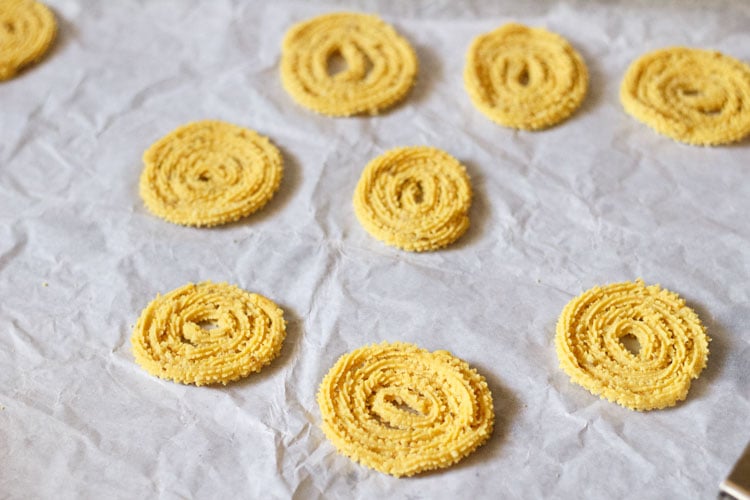
19. Gently flip when one side is golden and continue to fry. The thin spirals should turn a beautiful golden color when they’re done.
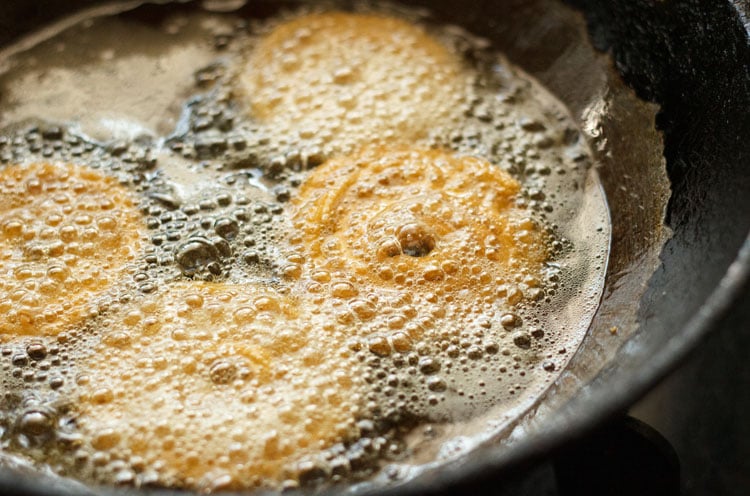
20. Use a spider spatula or a slotted spoon to remove the chakli as soon as they start to brown. Pay attention as they will fry quickly!
Place them on a paper towel to remove any excess oil.
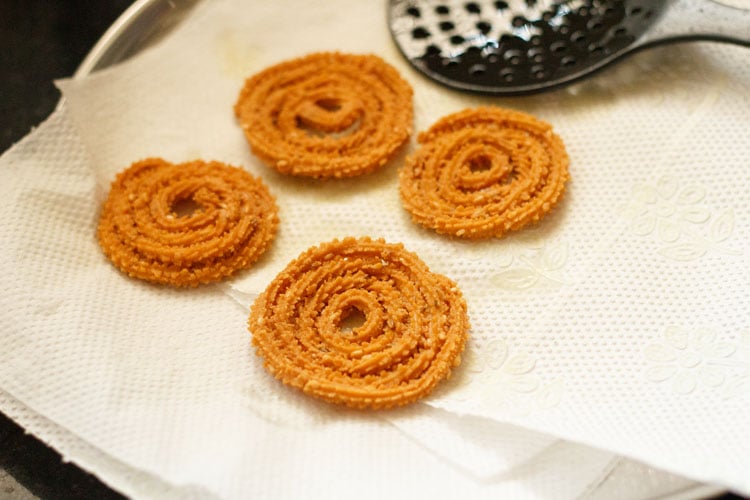
21. Fry the remaining batches in the same way. Once the chakli have cooled, store them in an airtight container in a cool dry place at room temperature for up to a week or a month.
You can make a large batch of this recipe by scaling it up.
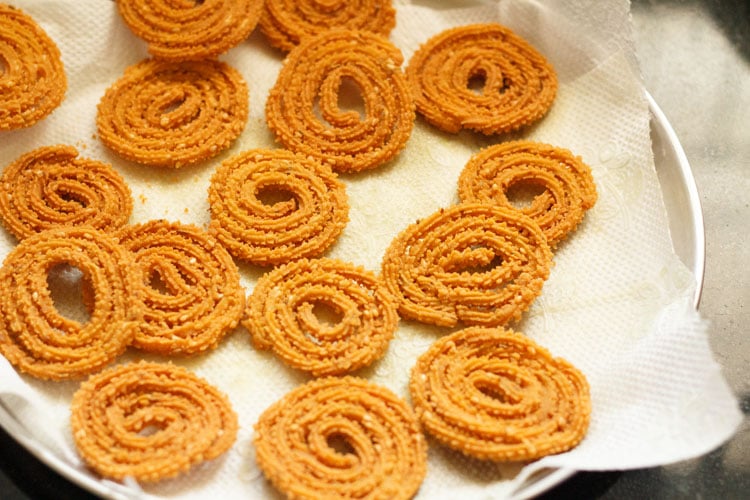
22. Serve chakli as a crunchy, savory snack with a delicious Masala Chai to drink.
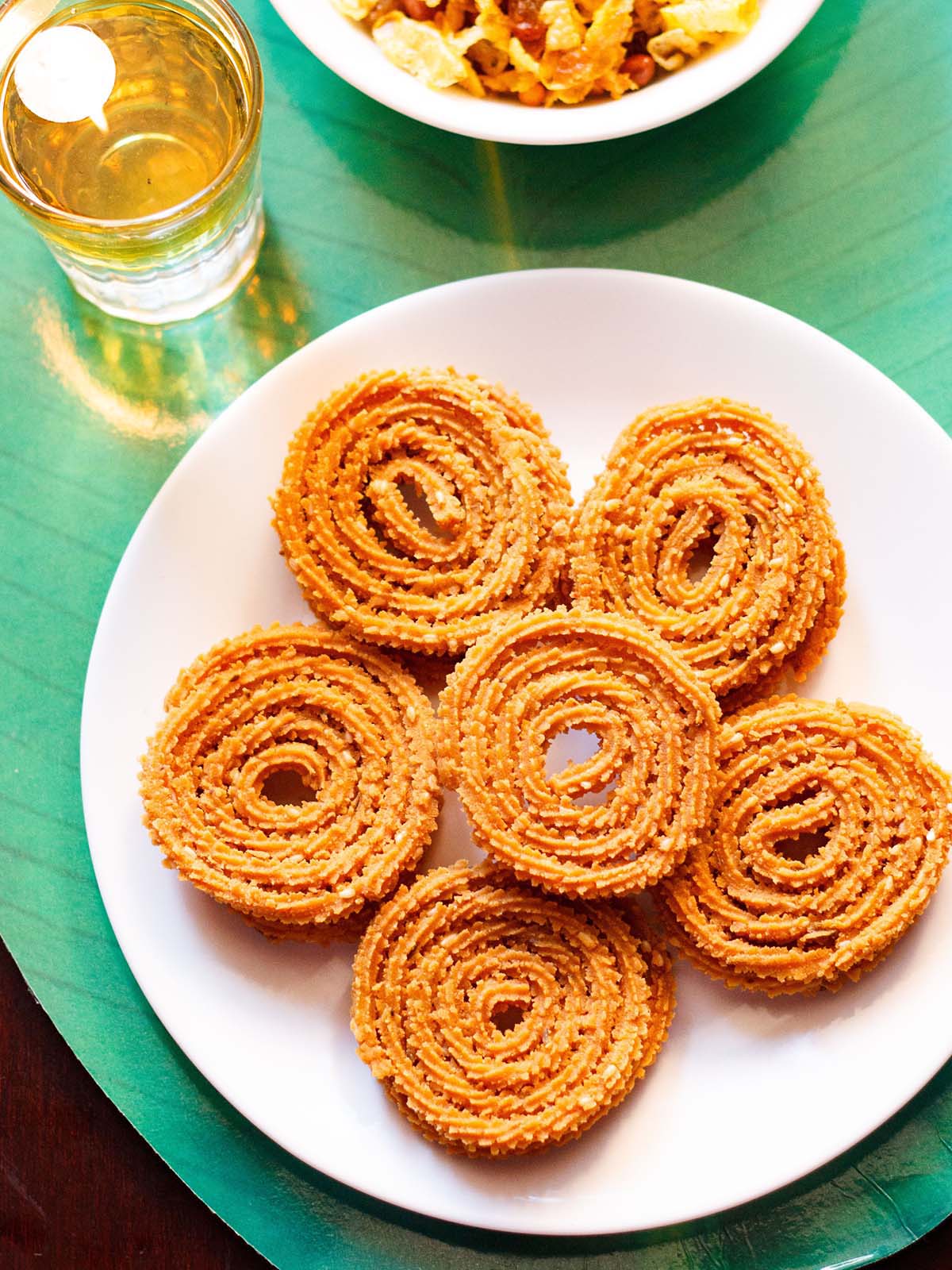
Expert Tips
I have noted below many tips so that it helps you to make perfect chakli similar to the ones brought from shops.
1. On Dough Consistency
The dough should be firm but not crumbly, floury, hard or sticky. Adding water in parts knead the dough as this will help you to gauge the correct consistency in it.
If at all you have added more water, then do not panic. Just add some tablespoons of rice flour and incorporate it into the dough.
The chakli dough does not have gluten in it, so you do not have to worry on over-kneading or under-kneading the dough.
If the dough looks floury, dry or dense, then sprinkle a few teaspoons of water at a time and gently mix it with the dough till you get the correct consistency.
2. On Forming Chakli
When making the chakli spirals, use a butter paper or parchment paper or aluminum foil, so that it’s easy to remove them. You could also use small parchment paper squares and with its support, gently slid the chakli in oil.
If the dough strands break then the moisture is less in the dough. So add 2 to 3 teaspoons of water and knead the dough again.
If the dough is too moist you won’t get a proper spiral shape. Add a few teaspoons of rice flour and knead until you get a dough which is firm but still pliable.
After frying, if the chakli tastes hard, this means the fat has become less in the dough. Add 1 to 2 teaspoons hot oil or butter to the dough and knead again.
If it looks like the chakli has absorbed much oil or breaks in the oil, then there is more fat the dough. Try adding some rice flour to the dough, about 1 to 2 tablespoons at a time, and knead again.
3. On Deep Frying
Fry chakli on medium to medium-high heat at a temperature of 180 degrees Celsius to 190 degrees Celsius (360 degrees Fahrenheit to 375 degrees Fahrenheit) – that you can easily measure with a candy or deep fry thermometer.
When you do not have a thermometer, then the way to check is by adding a tiny piece of the dough in the hot oil. If it rises to the surface in 3 to 4 seconds and begins to sizzle, the oil is ready.
Never fry chakli at a low heat. This will make the chakli soggy with oil and they will become soft instead of crispy and crunchy.
Do not fry them on high heat as this will brown them too fast and possibly burn them too.
I hope you have a safe and fun Diwali enjoying these delicious chakli! And I’m sure you’ll want to make this recipe all year!
More Popular Maharashtrian Snacks To Try!
Evening Snacks
Sweets Recipes
Evening Snacks
Please be sure to rate the recipe in the recipe card or leave a comment below if you have made it. For more vegetarian inspirations, Sign Up for my emails or follow me on Instagram, Youtube, Facebook, Pinterest or Twitter.
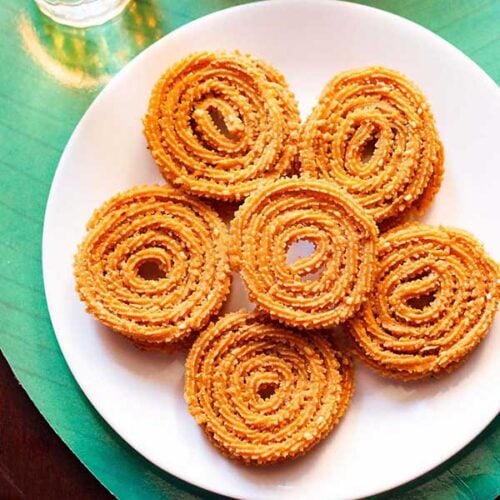
Chakli Recipe
Ingredients
- 1 cup Rice Flour – 150 to 160 grams
- ½ cup besan (gram flour) – 50 to 60 grams
- 2.5 tablespoon oil or softened butter
- ⅔ to ¾ cup water – add as required
- ¼ teaspoon turmeric powder
- ½ teaspoon carom seeds (ajwain)
- ½ teaspoon cumin seeds
- 1 teaspoon red chili powder or add as required
- 1 generous pinch asafoetida (hing) – optional
- 1 tablespoon sesame seeds – white or black
- salt as required
- oil for deep frying – any neutral high smoke-point oil
Instructions
Making dough
- First take the rice flour and gram flour in a bowl.
- Add the carom seeds, cumin seeds, sesame seeds, turmeric powder, red chili powder, asafoetida and salt.
- Mix everything with a spoon.
- Heat butter or oil in a bowl or small pan to a slight simmer but do not boil or burn.
- Add the hot butter or oil to flour mixture.
- Mix the butter or oil with a spoon first. When the mixture becomes warm, then use your fingertips to thoroughly combine. Set aside.
- In a sauce pan heat water until it starts boiling.
- Add this hot water in parts to the flour mixture. Mix with a spoon.
- Add more hot water as required. Mix with a spoon first and then using slightly damp hands knead to a firm yet pliable dough.
- Cover and let the dough rest for 30 minutes.
Making chakli
- Apply some water in the chakli/murukku maker and place a portion of the dough inside it.
- Tighten the lid and press the chakli maker to prepare the chakli. Move in rounds to get a spiral shape. Make the chakli on butter paper or aluminium foil, so thats it is easy to remove them.
- TIP – If the chakli breaks while forming them, this means that the dough does not have enough moisture. Add 1 or 2 tablespoons of water and knead the dough again.
- TIP – If you are not getting proper shape, this mean that the dough is too moist. Add some flour and knead again.
- Break the dough towards the end and press it to the last concentric circle of the spiral.
Frying
- Heat oil for deep frying in a pan. Take a small piece of the dough and check the temperature of the oil.
- If the dough comes up gradually, then the oil is ready. If the dough sits at the bottom, the oil is still cold. If the piece of dough comes up briskly and quickly, the oil is too hot.
- TIP – Have a bite into the fried piece of dough and if it tastes hard, add ½ or 1 tablespoon of hot oil or butter to the dough and knead again.
- Lift the chakli gently and slid into the hot oil.
- Fry 3 to 4 chakli at a time. Do not over crowd the kadai or pan while frying.
- TIP – Check the first batch of chakli. If it looks like the chakli has absorbed oil or breaks in oil, then add some rice flour, about 1 to 2 tablespoons and knead again. This happens if too much fat has gone in the dough.
- Fry them until crisp and golden.
- Drain them on paper towels to remove extra oil.
- Make chakli with the remaining dough on the parchment paper. Cover them with a dry kitchen napkin, so that they don't dry out.
- Fry the remaining batches in the same way. Once they come at room temperature, then store them in an airtight box or jar. Keep the jar in a cool dry place at room temperature.
- Serve chakli plain as a snack with some masala chai or ginger tea.
Notes
- To make the chakli spicy, you add more red chili powder or even garlic-green chili paste.
- The dough should be firm but not crumbly, floury, hard or sticky. Add water in parts while kneading.
- If dough has become sticky, then add a few tablespoons of rice flour and knead.
- If the dough looks floury or dense, then sprinkle a few teaspoons of water at a time and gently mix it with the dough till you get the correct consistency.
- When making the chakli spirals, use a butter paper or parchment paper or aluminum foil, so that it’s easy to remove them. You could also use small parchment paper squares and with its support, gently slid the chakli in oil.
- If the dough strands break while forming chakli, then the moisture is less in the dough. Add 2 to 3 teaspoons of water and knead again.
- A moist dough won’t give a neat and proper spiral shape. To rectify, add a few teaspoons of rice flour. Knead again to a firm but pliable dough.
- After frying, if the chakli tastes hard, this means the fat has become less in the dough. Add 1 to 2 teaspoons hot oil or butter to the dough and knead again.
- If the chakli has absorbed much oil or breaks in the oil, then there is more fat the dough. Try adding some rice flour to the dough, about 1 to 2 tablespoons at a time, and knead again.
- Fry chakli on medium to medium-high flame. Add a tiny piece of the dough in the hot oil. If it rises to the surface in 3 to 4 seconds and begins to sizzle, the oil is ready.
- Do not fry chakli at a low heat. This will make them soggy with oil and they will become soft instead of crispy and crunchy.
- Avoid frying chakli on high heat as this will brown them too fast and can burn them.
Nutrition Info (Approximate Values)
This Chakli Recipe post from the archives, first published in October 2014 has been republished and updated on 21 October 2022.
